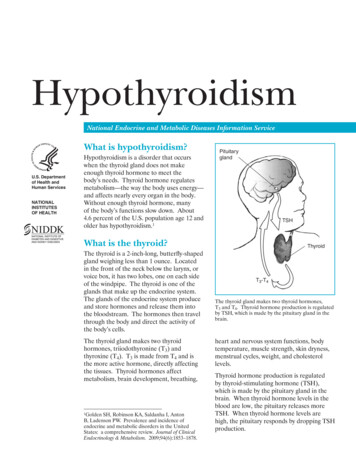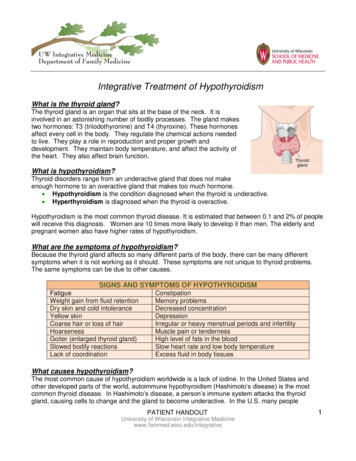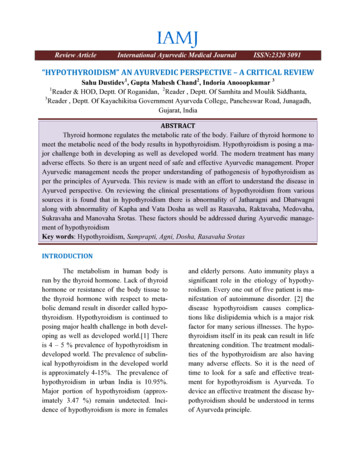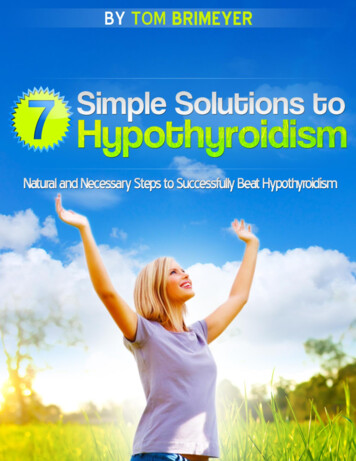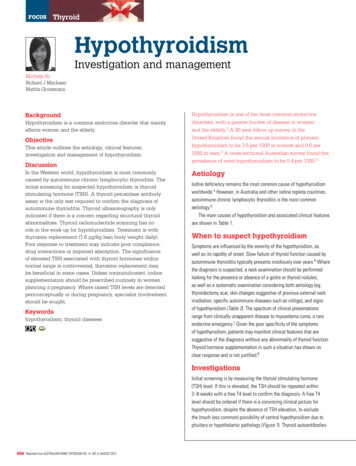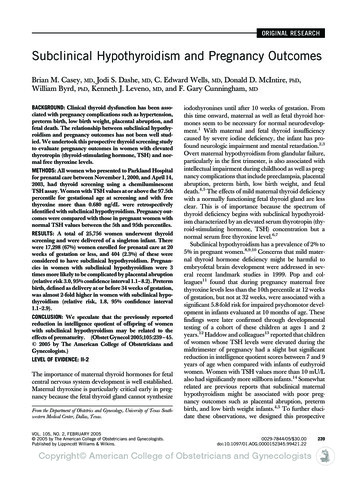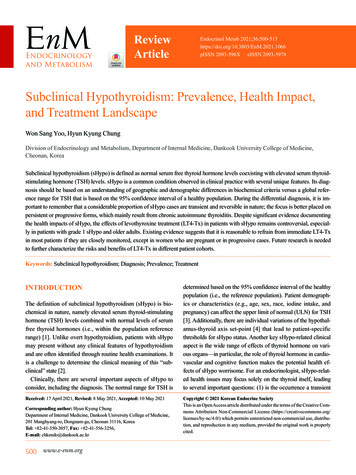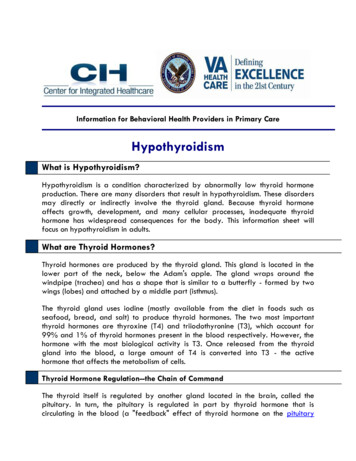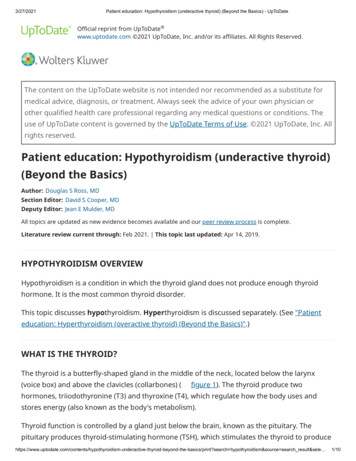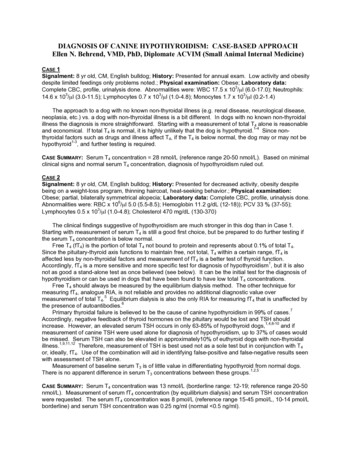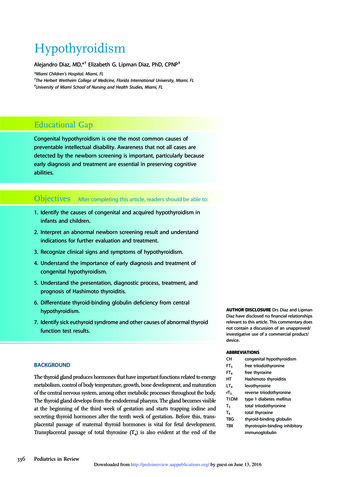
Transcription
HypothyroidismAlejandro Diaz, MD,*† Elizabeth G. Lipman Diaz, PhD, CPNP‡*Miami Children’s Hospital, Miami, FL†The Herbert Wertheim College of Medicine, Florida International University, Miami, FL‡University of Miami School of Nursing and Health Studies, Miami, FLEducational GapCongenital hypothyroidism is one the most common causes ofpreventable intellectual disability. Awareness that not all cases aredetected by the newborn screening is important, particularly becauseearly diagnosis and treatment are essential in preserving cognitiveabilities.ObjectivesAfter completing this article, readers should be able to:1. Identify the causes of congenital and acquired hypothyroidism ininfants and children.2. Interpret an abnormal newborn screening result and understandindications for further evaluation and treatment.3. Recognize clinical signs and symptoms of hypothyroidism.4. Understand the importance of early diagnosis and treatment ofcongenital hypothyroidism.5. Understand the presentation, diagnostic process, treatment, andprognosis of Hashimoto thyroiditis.6. Differentiate thyroid-binding globulin deficiency from centralhypothyroidism.7. Identify sick euthyroid syndrome and other causes of abnormal thyroidfunction test results.BACKGROUNDThe thyroid gland produces hormones that have important functions related to energymetabolism, control of body temperature, growth, bone development, and maturationof the central nervous system, among other metabolic processes throughout the body.The thyroid gland develops from the endodermal pharynx. The gland becomes visibleat the beginning of the third week of gestation and starts trapping iodine andsecreting thyroid hormones after the tenth week of gestation. Before this, transplacental passage of maternal thyroid hormones is vital for fetal development.Transplacental passage of total thyroxine (T4) is also evident at the end of the336AUTHOR DISCLOSURE Drs Diaz and LipmanDiaz have disclosed no financial relationshipsrelevant to this article. This commentary doesnot contain a discussion of an unapproved/investigative use of a commercial product/device.ABBREVIATIONSCHcongenital hypothyroidismFT3free triiodothyroninefree thyroxineFT4HTHashimoto thyroiditisLT4levothyroxinereverse triiodothyroninerT3T1DMtype 1 diabetes mellitusT3total triiodothyroninetotal thyroxineT4TBGthyroid-binding globulinTBIIthyrotropin-binding inhibitoryimmunoglobulinPediatrics in ReviewDownloaded from http://pedsinreview.aappublications.org/ by guest on June 13, 2016
gestation, when approximately one-third of maternal T4 passesto the fetus. Because of the 3.7-day half-life of T4 in thenewborn, maternal sources of T4 take between 2 and 3 weeksto be metabolized and excreted. At delivery, exposure to a coldenvironment causes a surge of thyrotropin within 30 minutes,as high as 160 mIU/L, with a subsequent increase in T4 andtotal triiodothyronine (T3). Thyrotropin decreases significantlyby 48 hours after birth, reaching infant levels of less than10 mIU/L by the fifth day after birth.DEFINITIONHypothyroidism is a deficiency in thyroid hormone production by the thyroid gland, with ensuing metabolic and neurologic effects at the cellular level. The most common causesof hypothyroidism in iodine-replete regions of the world arecongenital hypothyroidism (CH) and Hashimoto thyroiditis(HT). Hypothyroidism has a wide spectrum of clinical presentations, from transient and subclinical forms to severecases, the latter with catastrophic neurologic consequenceswhen present in the neonatal period without early diagnosis.Subclinical hypothyroidism is defined as an elevated thyrotropin level with normal T4 and free thyroxine (FT4) levels,and lack of signs or symptoms of hypothyroidism.HYPOTHYROIDISM IN THE NEONATAL PERIODEpidemiologyCH is the most common congenital endocrine disorder andthe most common preventable cause of intellectual disability.Before the implementation of newborn screenings, the incidence of CH was approximately 1 in 7,000 live births. Afterthe advent of newborn screenings in the mid-1970s, theincidence increased to 1 in 4,000 live births. The incidenceappears to have continued increasing during the past fewdecades, in part due to changing demographics in developedcountries and the lowering of the thyrotropin cutoff values bynewborn screening programs which has increased the diagnosis of milder cases. The most recently reported incidence ofCH in the general population of North America is approximately 1 in 2,500 live births, with wide variation according togeographic location and ethnic background. In 2008, a workshop of epidemiological experts evaluating the incidence ofCH by race/ethnicity in California among infants bornbetween 2001 and 2007 reported the incidences as 1 in1,200 live births among Asian Indians, 1 in 1,600 live birthsamong Hispanics, 1 in 2,380 live births among Asians, 1 in3,533 live births among non-Hispanic whites, and 1 in 11,000live births among non-Hispanic blacks. (1) Recent surveys ofnewborns from New York State and Massachusetts reportincidences of 1 in 1,415 and 1 in 1,660 live births, respectively.(2) The increasing incidence of CH has also been documentedin European populations and presently is as follows: British, 1in 1,077; Greeks, 1 in 1,749; and Italians, 1 in 2,200. (2) Thereis a 2:1 female to male ratio in CH, secondary to thyroiddysgenesis. The risk of CH is higher among newborns withbirth weights less than 2,000 g and greater than 4,500 g.Approximately 5% of newborns in the general population havea birth defect; the prevalence increases to approximately 10%in newborns with CH. Transient CH is more common amongpremature infants. Maternal hypothyroidism has been associated with transient hypothyroidism, and paternal hypothyroidism has been associated with CH.EtiologyThe most common cause of primary CH is abnormal development of the thyroid gland (dysgenesis), which correspondsto approximately 85% of cases. Approximately 66% of thesecases are secondary to an ectopic location of the thyroidgland, followed by aplasia or hypoplasia of the gland. Mostcases of thyroid dysgenesis or agenesis are sporadic andidiopathic. However, certain mutations in the genes encoding transcription factors involved in thyroid gland development have been reported in approximately 2% of these cases.(3) A defect in the normal production of thyroid hormonesdue to defects in enzymes and ion transporters, known asdyshormonogenesis, corresponds to approximately 10% to15% of the cases of CH. These conditions are inherited inan autosomal recessive pattern.Iatrogenic CH is seen in infants whose mothers receivedradioactive iodine after the 10th week of gestation. Therefore,any woman of childbearing age should have a pregnancy testperformed before receiving diagnostic or therapeutic radioactive iodine. Central or secondary/tertiary hypothyroidismoccurs in approximately 1 in 25,000 to 1 in 50,000 live birthsand is most commonly associated with other pituitary hormone deficiencies related to mutations in transcription factors associated with the development of the pituitary gland(see below). Transient CH is found in children whose mothers were treated with antithyroid medications during pregnancy. It is also seen in cases of excess or deficient maternaliodine intake, maternal thyrotropin-binding inhibitory immunoglobulin (TBII), or heterozygous mutations of THOX2or DUOXA2. Children with large congenital hepatic hemangiomas due to increased type 3 deiodinase activity may alsohave transient CH. (3)In the preterm infant, the surge of thyrotropin, T4, and T3 isattenuated due to hypothalamic-pituitary-thyroid axis immaturity. Compared with full-term infants, these infants have lowerlevels of T4. Levels of thyrotropin, FT4, and T3 are normal toVol. 35 No. 8Downloaded from http://pedsinreview.aappublications.org/ by guest on June 13, 2016AUGUST 2014337
low, and thyroglobulin levels are high in preterm infantsbecause of an increased production of poorly iodinated thyroid hormone precursor. Low levels of thyroid-binding globulins (TBGs) contribute to the physiologic hypothyroxinemiaof prematurity, which worsens according to the infant’sdegree of prematurity. In sick premature infants, this hypothyroxinemia may also be related to sick euthyroid syndrome,also known as nonthyroidal illness syndrome (discussed later).Male newborns with TBG deficiency have low levels of T4and T3 and normal levels of FT4, free triiodothyronine (FT3),and thyrotropin. Newborns with low levels of albumin havesimilar, though milder, laboratory findings (discussed later).A diagram that summarizes the pathogenesis of hypothyroidism is presented in the Figure. The most common causesof CH are presented in Table 1.Signs and SymptomsMost newborns with CH do not have detectable clinicalmanifestations at birth due to the transplacental passage ofmaternal thyroid hormones. Further, most of these newbornshave some thyroid function, unless they have thyroid agenesis. Even among infants with thyroid agenesis, the placentalpassage of T4 and the lack of specific signs and symptomsof hypothyroidism make clinical diagnosis difficult. Whenearly clinical findings are in fact present, usually it is amongneonates with thyroid agenesis or total absence of thyroidhormone production and maternal hypothyroidism. Thoseinfants whose mothers had normal thyroid hormone production may have only mild signs or symptoms during theneonatal period that become increasingly evident thereafter.Signs and symptoms of CH are presented in Table 2.Diagnostic EvaluationNewborn screening. Worldwide, approximately 25% of children are born in countries with newborn screening programs. In these countries, almost all infants with CH arediagnosed in the neonatal period. Newborn thyroid screeningsamples are collected from a heel-prick blood specimen ona filter paper between the second and fifth days after birth.Some programs obtain a second sample between the secondand sixth weeks of age or upon hospital discharge if the infanthas been admitted to a neonatal intensive care unit. Somenewborns who are discharged from the hospital on the firstday after birth have the sample taken at this time. The filterpaper is mailed to a centralized laboratory. Each program hasits own parameters for test results. Most programs in theUnited States evaluate thyrotropin levels, and measure T4only if the thyrotropin level is higher than their cutoff. Otherprograms evaluate T4 with a reflex thyrotropin test in newborns with a T4 level below the laboratory cutoff. Someprograms routinely test both thyrotropin and T4. In general,if the T4 level is below the 10th percentile and/or thethyrotropin level is greater than 30 mIU/L, the designatedphysician is immediately contacted to arrange furtherevaluation and treatment. Some programs that use lowerthyrotropin cutoff values identify more cases of mild hypothyroidism, but also generate more false-positive results.If the T4 level is low and the thyrotropin level is normal, or ifthe T4 level is normal and the thyrotropin level is slightlyelevated but less than 40 mIU/L, some programs mayrecommend a repeat filter paper sample. The main disadvantage of programs that use only thyrotropin is the inabilityto detect cases of central hypothyroidism. False-positiveFigure. Pathogenesis of hypothyroidism.FT4¼free thyroxine; LT4¼levothyroxine;T4¼total thyroxine; TBII¼thyrotropinbinding inhibitory immunoglobulins;TPO¼thyroid peroxidase.338Pediatrics in ReviewDownloaded from http://pedsinreview.aappublications.org/ by guest on June 13, 2016
TABLE 1.Causes of Congenital HypothyroidismTABLE 2.Primary CHSigns and Symptoms of CongenitalHypothyroidismEarly findingsThyroid dysgenesisAplasiaMacrosomiaHypoplasiaDecreased activityEctopic glandLarge anterior fontanelleThyroid dyshormonogenesisEdema of the eyelids, hands, and feetSodium-iodine symporter (trapping) defectProlonged jaundiceThyroid peroxidase defectHypotoniaThyroglobulin defectCoarse facial featuresDeiodinase defectHypothermiaResistant to thyrotropin binding or signalingPallorThyrotropin receptor defectGoiterG protein defectProtuberant abdomenLate findings (after the neonatal period)IatrogenicRadioactive iodine given to the pregnant mother after8 weeks of gestationSecondary (central) hypothyroidism (see Table 7)Peripheral CHPoor sucking effortDevelopmental delayDecreased activity and lethargyPoor growthThyroid hormone transport defect (monocarboxylatetransporter 8)Umbilical herniaThyroid hormone metabolism defect (selenocysteineinsertion sequence-binding protein 2)Mottled, cool, and dry skinThyroid hormone resistanceMacroglossiaTransient CHDifficult breathingGeneralized swelling (myxedema)Maternal or neonatal excess iodine exposureHoarse cryMaternal or neonatal iodine deficiencyMaternal antithyroid drugsMaternal thyrotropin receptor binding inhibitoryimmunoglobulinHeterozygous THOX2 or DUOXA2 mutationsCongenital hepatic hemangiomaselevations in thyrotropin levels may be found when a samplewas collected within the first 48 hours after birth. Amongthese infants, repeating the newborn screening at 2 weeksafter birth is recommended. False-negative results may befound in critically ill infants or after blood transfusion. Themost common causes of hypothyroidism and correspondinglaboratory test findings are presented in Table 3.Confirmatory testing. Newborns with abnormal thyroidscreening test results should be referred immediately forevaluation and confirmatory testing. A blood specimen forthyrotropin and FT4 measurement should be obtained. If T4is ordered instead of FT4, TBG should be evaluated or a T3resin uptake test should be performed to avoid missingcases of TBG deficiency. In this condition (discussed below),the TBG level is low and T3 resin uptake is elevated. The T3resin uptake is an indirect measure of the binding capacityof TBG. In this test, T3 resin binder is mixed with serumfrom the patient and a trace amount of iodine 125–labeled T3is added. If the patient has low levels of TBG, the TBG wouldbe saturated; therefore, a higher fraction of iodine 125–labeled T3 binds to the resin. Thyrotropin values after thefirst week after birth should be less than 10 mIU/L. Primaryhypothyroidism is confirmed if the infant has an elevatedthyrotropin level with a low FT4 level. Some preterm and/ornewborns with low birth weights have low T4 levels andnormal thyrotropin levels. Their T4 level usually normalizesby the sixth week after birth. If their T4 and/or FT4 level isVol. 35 No. 8Downloaded from http://pedsinreview.aappublications.org/ by guest on June 13, 2016AUGUST 2014339
very low and/or continues to be low after the sixth week afterbirth, the diagnosis of central hypothyroidism is likely. Someacutely ill infants have low levels of T4 and FT4 as part of sickeuthyroid syndrome. This diagnosis is confirmed with adetection of an elevated reverse T3 (rT3) level. Some authorsrecommend evaluation of FT4 by the equilibrium dialysismethod when the FT4 level is borderline abnormal or doesnot correspond to clinical manifestations. In the equilibriumdialysis method, patient serum is dialyzed against a buffer for16 to 18 hours, separating FT4 molecules from the proteinbound T4 molecules. FT4 molecules are able to cross thedialysis membrane because they are small and can be measured without being affected by TBG concentrations orthyroid autoantibodies. However, this test is time-consumingand expensive. Approximately 30% of children with a positivenewborn screening result have definitive CH (elevated thyrotropin level with low FT4 level).Further imaging and laboratory evaluation may be performed to clarify the origin of thyroid disorder. A thyroid scanis the best test to determine the size and location of the thyroidgland. It can be performed within the first days of therapy, anda serum thyrotropin level should be measured at the time of thescan. In newborns, this test should be performed with iodine123 or sodium pertechnetate Tc 99m. Absent radioactiveisotope uptake is seen in thyroid aplasia, maternal TBII,thyrotropin b-mutations, thyrotropin receptor–inactivatingmutations, and iodide-trapping defects. In cases of absentuptake, ultrasonography of the thyroid should be performedto determine whether the thyroid gland is present. An enlargedgland with increased uptake is seen in infants with dyshormonogenesis. In these cases, a perchlorate discharge and/orgenetic tests are helpful to establish the diagnosis. Ultrasonography of the thyroid may also be ordered as the initial test;however, it is not as accurate as a scan in identifying ectopicglands. Infants with absent uptake on scan, a normal or smallthyroid gland by ultrasonography, or a maternal history ofautoimmune thyroid disease should have TBII measured.CH due to the presence of TBII antibodies, which blockthe thyrotropin receptor, is transient, lasting from a fewweeks to 6 months after birth.Insufficient or excessive iodine intake or exposure canproduce hypothyroidism or hyperthyroidism. In infants withCH, born in areas of endemic iodine deficiency, measurement of urinary iodine will confirm low iodine levels. If thereis a history of maternal excessive iodine ingestion or neonatalexposure to iodine, urinary iodine determination will confirmthis diagnosis. The normal urinary iodine range in a neonateis approximately 50 to 100 mg/24 hours (nmol/24 hours). (3)Normal thyroid function test values according to age arepresented in Table 4.340TABLE 3.Causes of Hypothyroidism andLaboratory FindingsPrimary hypothyroidism(eg, dysgenesis, agenesis,dyshormonogenesis, andHashimoto thyroiditis)Elevated thyrotropin levelwith low T4 and FT4 levels;positive TPO and/orthyroglobulin antibodytest resultsSubclinical hypothyroidismSlightly elevated thyrotropinlevel with normal T4and FT4 levelsTBG deficiencyNormal thyrotropin levelwith low T4 level,normal FT4 level, andlow TBG levelsCentral hypothyroidismLow, normal, or slightlyelevated thyrotropin levelswith low T4 and/or FT4 levelsMild sick euthyroidsyndromeNormal thyrotropin level,low T3 level, elevated rT3level, normal T4 and FT4 levelsModerate sick euthyroidsyndromeNormal thyrotropin level, lowT3 level, elevated rT3 level,low T4 and FT4 levelsSevere sick euthyroidsyndromeLow thyrotropin level, low T3level, elevated rT3 level, lowT4 level, and low FT4 levelResistance to thyroidhormoneNormal or slightly elevatedthyrotropin level withelevated T4, T3, FT4,and FT3 levelsFT3¼free triiodothyronine; FT4¼free thyroxine; rT3¼reversetriiodothyronine; T3¼total triiodothyronine; T4¼total thyroxine;TBG¼thyroid-binding globulin; TPO¼thyroid peroxidase.TreatmentBecause of the known correlation between the intelligencequotient (IQ) and the timing of thyroid hormone replacement initiation, treatment with levothyroxine (LT4) shouldbe started as soon as a diagnostic evaluation confirms thediagnosis of CH. If the thyrotropin level is greater than 40mIU/L and the T4 level is low, LT4 should be startedimmediately after confirmatory samples have been taken,without waiting for results.The initial recommended dose of LT4 for infants with CHis 10 to 15 mg/kg daily. In the United States, only tabletformulations are approved for treatment; thus, the tabletshould be crushed and mixed with water, breast milk, orformula. Thyrotropin, FT4, and T4 should be evaluated at 2and 4 weeks after the initiation of LT4 treatment. Thereafter,thyroid function levels should be measured every 1 to 2months for the first 6 months after birth, every 2 to 3 monthsbetween age 6 months and 3 years, and every 6 to 12 monthsPediatrics in ReviewDownloaded from http://pedsinreview.aappublications.org/ by guest on June 13, 2016
TABLE 4.Normal Thyroid Function Values in Infancy and ChildhoodaAGET4, mG/DL(NMOL/L)FT4, NG/DL(PMOL/L)T3, NG/DL(NMOL/L)RT3, NG/DL(NMOL/L)TBG, mG/ML(NMOL/L)THYROTROPIN,MIU/LPremature Infants26–32 weeks(day 3–4)2.6–14.0 (44–239)24–132 (0.37–2.03)0.8–6.9Full-term infants0.94–4.4 (12–57)bNewborns1–3 Days8.2–19.9 (140–340)90–250 (1.39–3.85) 19.2–44.7 (328–764)b 25–160 at 30minutes afterbirth1.9–17.58b89–405 (1.37–6.24)Day 41 Week1.3–16b6.0–15.9 (103–272) 0.95–4.0 (12–51)b91–300 (1.40–4.62)10–50 (0.15–0.77) 19.2–44.7 (328–764)0.58–5.58b10–50 (0.15–0.77)0.9–7.71–11 Months0.65–1.9 (8–24)85–250 (1.31–3.85)Prepubertalchildren0.65–1.9 (8–24)119–218 (1.83–3.36)10–50 (0.15–0.77) 12.7–27.9 (217–477)0.6–5.580–185 (1.23–2.85)10–50 (0.15–0.77) 12.7–27.9 (217–477)0.5–4.81–2 Years6.8–13.5 (116–231)3–10 Years5.5–12.8 (94–219)Pubertal children4.9–13.0 (84–222)0.8–1.7 (10–22)FT4¼free thyroxine; T3¼total triiodothyronine; T4¼total thyroxine; TBG¼thyroid-binding globulin; rT3¼reverse triiodothyronine.aData are ranges – 2 SDS from mean values. Data are from the Endocrine Sciences Laboratory (2011) and Lem et al. J Clin Endocrinol Metab. 2012;97(9):3170–3278.bFT4 and thyrotropin were determined by chemiluminescence assays. TBG was measured by immunometric assay.thereafter. Evaluation of thyroid function 4 weeks aftera change in LT4 dosage is also recommended. The targetrange for FT4 should be in the upper half of the laboratoryreference range for age. The T4 level should be between 10and 16 mg/dL (171–273 nmol/L) for the first 2 years afterbirth; thereafter, levels should be on the upper half of thereference range for age. Maintaining TSH levels to below 5mIU/L, ideally between 0.5 and 2 mIU/L, is recommended;however, some infants with CH have a certain degree ofthyroid hormone resistance, and their thyrotropin level isnot easily maintained within the recommended valueswithout increasing levels of T4 and FT4 above the upper limits.In these cases and among infants with central hypothyroidism,when thyrotropin levels cannot be determined, monitoringshould be based on T4 and FT4 levels. Because of the lack ofbioequivalence among different brands of LT4, it is not recommended to substitute different LT4 formulations, particularly in cases of severe CH during the first 3 years after birth. Ifno signs of permanent hypothyroidism are obvious and thechild has a eutopic thyroid gland, discontinuation of LT4 for 30days, with subsequent thyrotropin and FT4 measurement, isrecommended after age 3 years. If the levels are within thereference range, the diagnosis of transient hypothyroidism canbe made; otherwise, treatment should be resumed. Childrenwith a history of transient hypothyroidism should be carefullyfollowed up for clinical symptoms, and thyroid tests should beperformed if recurrence is suspected. Approximately one thirdof children with CH and eutopic thyroid gland will need tocontinue LT4 treatment after reevaluation.Delayed initiation of LT4 treatment and persistent suboptimal levels of T4 during the first year after birth have beenassociated with lower IQ attainment. A recent longitudinal,population-based cohort study found that young adults diagnosed with CH by neonatal screening reported a modest butsignificant increase in chronic diseases, visual problems,overweight, lower socioeconomic status, and lower full-timeemployment than their peers. The same study found analmost fourfold increase in hearing impairment amongthe CH group. (4) Hearing problems secondary to CH arepersistent despite early diagnosis. Decreased health-relatedquality of life, primarily due to lower cognitive functioning,has been reported in patients with a history of CH. Because ofthe higher risk of congenital anomalies among infants withCH, careful physical examination and hearing tests should beperformed. A summary of the treatment, monitoring, andthyroid function test targets are presented in Table 5.Vol. 35 No. 8Downloaded from http://pedsinreview.aappublications.org/ by guest on June 13, 2016AUGUST 2014341
If evaluated, thyrotropin shouldWithin reference range Middle and upper partsbe suppressed; if unsuppressed,of the reference rangeindicates undertreatmentEpidemiologyHT is the most common autoimmune disorder and the mostcommon cause of hypothyroidism in children and adults. Inpediatrics, most cases of HT are diagnosed during adolescence; however, it can present at any age, usually after the firstyear after birth. The prevalence of HT varies according to sex,ethnicity, and geographic location. The presence of positiveantithyroid antibodies in the general population increaseswith age, from 5% to 10% among young adults to 10% to20% among older adults. Women have 2 to 4 times theprevalence of antithyroid antibodies compared to men.Whites are affected more than Mexican Americans, whileAfrican Americans have the lowest prevalence. Iodinedeficient populations appear to have a lower incidence ofHT and hypothyroidism. (5) HT is more commonly foundin children with other autoimmune disorders or syndromes,especially Down syndrome, Turner syndrome, Noonan syndrome, type 1 diabetes mellitus (T1DM), and celiac disease.A list of the autoimmune syndromes that may include HTis presented in Table 6.EtiologyFT4¼free thyroxine; LT4¼levothyroxine; T4¼thyroxine.Central hypothyroidism Same as in congenitalSame as in congenital hypothyroidism ifhypothyroidism if diagnoseddiagnosed in infancy and same as inin infancy and same as inacquired primary hypothyroidismacquired primary hypothyroidismif diagnosed laterif diagnosed laterBetween 1 and 3 mU/LAcquired primaryhypothyroidism1–5 years 4–6 mg/kg daily6–10 years 3–4 mg/kg daily 11 years 2–3 mg/kg dailyRepeat thyroid function tests 6 to 8 weeksafter LT4 treatment is initiated or thedose is modified, then every 6 to 12months in children older than 3 yearsWithin reference range Within reference rangeUpper half of laboratoryreference range10–16 mg/dLLess than 5 mU/L, ideallybetween 0.5 and 2 mU/L10–15 mg/kg dailyCongenitalhypothyroidism2–4 Weeks after starting treatment.Every 1–2 months for first 6 monthsafter birthEvery 2–3 months between 6 monthsand 3 years after birthThen every 6–12 monthsTARGET FT4TARGET T4FREQUENCY OF THYROID FUNCTION TESTS TARGET THYROTROPINDOSE OF LT4CONDITIONTreatment, Monitoring, and Thyroid Function Test TargetsTABLE 5.342ACQUIRED PRIMARY HYPOTHYROIDISM: HASHIMOTO(AUTOIMMUNE) THYROIDITISSeveral factors are involved in the pathogenesis of HT, suchas infiltrating lymphocytes, cell expression of major histocompatibility complex class II, Fas-mediated apoptosis, andcytokine release. Approximately 70% of the individuals withthis condition have a genetic predisposition. As many as 20to 60 immunosusceptibility genes have been associatedwith HT. The disease is then ultimately triggered by environmental factors. (6) The pathogenesis of HT is caused byinfiltration of the thyroid gland by TH1 and TH2 cells. TH1cells regulate cell-mediated responses, which produce theprincipal damage to the gland. TH2 cells regulate B lymphocytes, which are involved in antibody production.Numerous cytokines, complement, and other mediatorsproduce damage to the thyrocytes, leading to cell deathby apoptosis. Two main types of antibodies found in patientswith HT are directed against thyroid peroxidase and thyroglobulin. These antithyroid antibodies do not appear to beimportant in the pathogenesis of HT. Pregnancy and environmental factors, such as infections, certain drugs (eg,lithium, amiodarone, interferon alfa, and hormone replacements, including estrogen), excess intake of iodine, stress,smoking, and toxins, are all considered triggers of thedisease. Goiter formation results from cellular infiltration and thyroid follicular cell proliferation secondary toPediatrics in ReviewDownloaded from http://pedsinreview.aappublications.org/ by guest on June 13, 2016
TABLE 6.Autoimmune Syndromes That MayInclude Hashimoto ThyroiditisAutoimmune polyglandular syndrome, type 1CandidiasisHypoparathyroidismAddison diseaseAutoimmune polyglandular syndrome, type 2Addison diseaseHashimoto thyroiditisType 1 diabetes mellitusPrimary hypogonadismMyasthenia gravisCeliac diseaseImmunodysregulation polyendocrinopathy X-linked syndromeEarly-onset type 1 diabetes mellitusColitisthyrotropin elevation in response to decreased thyroid hormone production.Symptoms and SignsApproximately 80% of children and adolescents with HTareasymptomatic at the time of diagnosis. A goiter is present inapproximately 70% of children with HT and is often the firstmanifestation of the condition. Children with moderate orsevere hypothyroidism are often detected on evaluation ofpoor growth velocity, decreased energy, declining schoolperformance, constipation, and/or dry skin. Some girls withsevere hypothyroidism may present with precocious pubertyand hyperprolactinemia, a condition known as the Van-WykGrumbach syndrome. Some children with prolonged hypothyroidism develop dyslipidemia.Some children with HT may present with clinical orsubclinical hyperthyroidism caused by the release of storedthyroid hormone from the affected thyroid gland. Theabsence of ophthalmologic findings on physical examinationand negative thyrotropin receptor–stimulating antibodies ornegative TBII test results help to differentiate this conditionfrom Graves disease, although both conditions may coexist inthe same patient, and occasionally signs and symptoms canalternate between one condition and the other. Hyperthyroidism secondary to HT is called Hashitoxicosis.On physical examination of patients with HT, the thyroidgland is diffusely enlarged and has a rubbery consistency.The surface is described as pebbly or bosselated. A lymphnode over the isthmus, called a Delphian node, may bepalpated.Diagnostic EvaluationThe initial laboratory evaluation of a child with suspectedhypothyroidism should include serum thyrotropin and FT4levels. A low FT4 value is diagnostic of hypothyroidism, andan elevated thyrotropin level is diagnostic for primaryhypothyroidism. If the thyrotropin level is low, normal, orslightly elevated in the presence of a low FT4 level, the likelydiagnosis is central hypothyroidism. Measurement of T4may help to clarify cases with borderline low or high FT4levels; however, measurement of T4 instead of FT4 can bemisguiding. The level
Hypothyroidism is a deficiency in thyroid hormone produc-tion by the thyroid gland, with ensuing metabolic and neu-rologiceffects atthecellularlevel.Themostcommoncauses of hypothyroidism in iodine-replete regions of the world are congenital hypothyroidism (CH) and Hashimoto thyroiditis (HT). Hypothyroidism has a wide spectrum of clinical pre-
